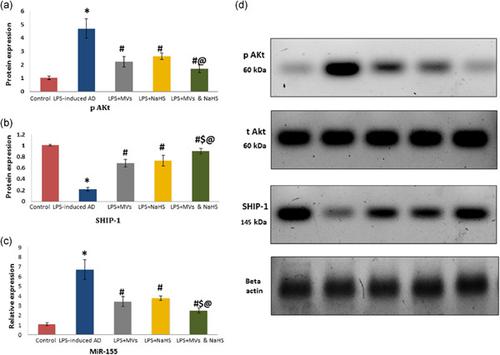当前位置:
X-MOL 学术
›
J. Cell. Physiol.
›
论文详情
Our official English website, www.x-mol.net, welcomes your
feedback! (Note: you will need to create a separate account there.)
Hydrogen sulfide and mesenchymal stem cells‐extracted microvesicles attenuate LPS‐induced Alzheimer's disease
Journal of Cellular Physiology ( IF 4.5 ) Pub Date : 2021-01-22 , DOI: 10.1002/jcp.30283 Basma E Aboulhoda 1 , Laila A Rashed 2 , Hoda Ahmed 2 , Eman M M Obaya 2 , Walaa Ibrahim 2 , Marwa A L Alkafass 2 , Sarah A Abd El-Aal 3 , Asmaa M ShamsEldeen 4
Journal of Cellular Physiology ( IF 4.5 ) Pub Date : 2021-01-22 , DOI: 10.1002/jcp.30283 Basma E Aboulhoda 1 , Laila A Rashed 2 , Hoda Ahmed 2 , Eman M M Obaya 2 , Walaa Ibrahim 2 , Marwa A L Alkafass 2 , Sarah A Abd El-Aal 3 , Asmaa M ShamsEldeen 4
Affiliation

|
Both hydrogen sulfide (H2S) and mesenchymal stem cells (MSCs) extracted microvesicles (MVs) are potent anti‐inflammatory molecules. They play an essential role in lowering the production of tumor necrosis factor‐alpha (TNF‐α). The latter could strongly stimulate MiR‐155 that contributes to neurodegeneration and Alzheimer's disease (AD). miR‐155 could repress the expression of inositol 5‐phosphatase‐1 (SHIP‐1) leading eventually to activation of Akt kinase and neurofibrillary development in AD. The current study was conducted to evaluate the role of miR‐155 in a rat model of lipopolysaccharide (LPS)‐induced AD and to investigate the effect of using MVs and H2S that were given either separately or combined in regulating pro‐inflammatory signaling. Thirty female Wistar albino rats aged 6 months to 1 year were equally divided into five groups; control group, LPS‐induced AD group, LPS + MVs group, LPS + NaHS group, and LPS + MVs and NaHS group. The increased miR‐155 level was associated with decreased SHIP‐1 level and positively correlated with TNF‐α. In addition, treatment with MVs and/or NaHS resulted in attenuation of inflammation, decreasing miR‐155, pAkt levels, and downregulation of apoptosis along with improvement of the hippocampal and cortical histopathological alterations. LPS enhanced production of malondialdehyde (MDA) and reduced glutathione (GSH) levels indicating oxidative stress‐induced neural damage, whereas MVs and NaHS could mitigate oxidative damage and accelerate antioxidant capacity via increasing catalase enzyme. In conclusion, downregulation of TNF‐α, miR‐155, and pAkt and increased SHIP‐1 could improve the neuro‐inflammatory state and cognitive function of LPS‐induced Alzheimer's disease.
中文翻译:

硫化氢和间充质干细胞提取的微泡可减轻脂多糖诱导的阿尔茨海默病
硫化氢 (H 2 S) 和间充质干细胞 (MSC) 提取的微泡 (MV) 都是有效的抗炎分子。它们在降低肿瘤坏死因子-α(TNF-α)的产生方面发挥着重要作用。后者可以强烈刺激 MiR-155,从而导致神经退行性疾病和阿尔茨海默病 (AD)。 miR-155 可以抑制肌醇 5-磷酸酶-1 (SHIP-1) 的表达,最终导致 AD 中 Akt 激酶的激活和神经原纤维的发育。本研究旨在评估 miR-155 在脂多糖 (LPS) 诱导的 AD 大鼠模型中的作用,并研究单独或联合给予 MV 和 H 2 S 在调节促炎信号传导方面的效果。 30只6月龄至1岁雌性Wistar白化大鼠,平均分为5组;对照组、LPS诱导的AD组、LPS+MVs组、LPS+NaHS组、LPS+MVs+NaHS组。 miR-155 水平升高与 SHIP-1 水平降低相关,并与 TNF-α 呈正相关。此外,MVs 和/或 NaHS 治疗可减轻炎症,降低 miR-155、pAkt 水平,下调细胞凋亡,同时改善海马和皮质组织病理学改变。 LPS 增强了丙二醛 (MDA) 的产生和还原型谷胱甘肽 (GSH) 的水平,表明氧化应激诱导的神经损伤,而 MV 和 NaHS 可以通过增加过氧化氢酶来减轻氧化损伤并加速抗氧化能力。总之,下调 TNF-α、miR-155 和 pAkt 以及增加 SHIP-1 可以改善 LPS 诱导的阿尔茨海默病的神经炎症状态和认知功能。
更新日期:2021-01-22
中文翻译:

硫化氢和间充质干细胞提取的微泡可减轻脂多糖诱导的阿尔茨海默病
硫化氢 (H 2 S) 和间充质干细胞 (MSC) 提取的微泡 (MV) 都是有效的抗炎分子。它们在降低肿瘤坏死因子-α(TNF-α)的产生方面发挥着重要作用。后者可以强烈刺激 MiR-155,从而导致神经退行性疾病和阿尔茨海默病 (AD)。 miR-155 可以抑制肌醇 5-磷酸酶-1 (SHIP-1) 的表达,最终导致 AD 中 Akt 激酶的激活和神经原纤维的发育。本研究旨在评估 miR-155 在脂多糖 (LPS) 诱导的 AD 大鼠模型中的作用,并研究单独或联合给予 MV 和 H 2 S 在调节促炎信号传导方面的效果。 30只6月龄至1岁雌性Wistar白化大鼠,平均分为5组;对照组、LPS诱导的AD组、LPS+MVs组、LPS+NaHS组、LPS+MVs+NaHS组。 miR-155 水平升高与 SHIP-1 水平降低相关,并与 TNF-α 呈正相关。此外,MVs 和/或 NaHS 治疗可减轻炎症,降低 miR-155、pAkt 水平,下调细胞凋亡,同时改善海马和皮质组织病理学改变。 LPS 增强了丙二醛 (MDA) 的产生和还原型谷胱甘肽 (GSH) 的水平,表明氧化应激诱导的神经损伤,而 MV 和 NaHS 可以通过增加过氧化氢酶来减轻氧化损伤并加速抗氧化能力。总之,下调 TNF-α、miR-155 和 pAkt 以及增加 SHIP-1 可以改善 LPS 诱导的阿尔茨海默病的神经炎症状态和认知功能。











































 京公网安备 11010802027423号
京公网安备 11010802027423号